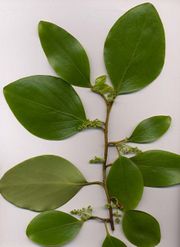Griselinia
| Griselinia subsp. var. | ||||||||||||||||||||||||||||||||||||||||||||||||||||||||
|---|---|---|---|---|---|---|---|---|---|---|---|---|---|---|---|---|---|---|---|---|---|---|---|---|---|---|---|---|---|---|---|---|---|---|---|---|---|---|---|---|---|---|---|---|---|---|---|---|---|---|---|---|---|---|---|---|

|
|
| ||||||||||||||||||||||||||||||||||||||||||||||||||||||
| ||||||||||||||||||||||||||||||||||||||||||||||||||||||||
Griselinia is a genus of seven species of shrubs and trees, with a highly disjunct distribution native to New Zealand and South America. It is a classic example of the Antarctic flora.
It is the sole genus in the family Griseliniaceae; in the past it was often placed in the Cornaceae (dogwood family, order Cornales), but differs from that in many features; recent genetic evidence from the Angiosperm Phylogeny Group has shown that it is correctly placed in the Apiales.
The leaves are evergreen, smooth and glossy above, often paler below. The flowers are very small, with five sepals and stamens and a single stigma. Petals 2-3 mm long. However, the female flower of G.lucida has no petals. The fruit is a small purple oval berry 5-10 mm long.
- New Zealand species
The two New Zealand species are large shrubs or trees, from 4-20 m tall. Both trees are or can be epiphytic or hemiphytic. Though sometimes occurring on rocky outcrops or coastal cliffs G.lucida is almost exclusively so. The young tree often colonizes amongst other epiphytes like Collospermum and Astelia high in the forest canopy, before growing aerial roots down the trunk of its host. Upon contact with the ground the roots can become large - up to 250 mm thick, and are easily identified for their heavy length wise corrugations. G. lucida seldom becomes a freestanding tree if having begun life epiphytically, and can often be seen to have collapsed where the host has died. Epiphytic growth in G.littoralis is less common but does occur in wetter climates.
Cultivation
Propagation
Pests and diseases
Varieties
The vernacular names from New Zealand species are of Māori origin.
- G. littoralis - Kapuka; leaves 6-14 cm long.
- G. lucida - Akapuka; differs from G. littoralis in larger leaves, to 12-18 cm long.
- South American species
The five South American species are smaller shrubs, 1-5 m tall. All are known as Yelmo.
- G. carlomunozii - coastal northern Chile (Antofagasta)
- G. jodinifolia - Chile
- G. racemosa - southern Chile (Los Lagos, Aisén) and adjacent Argentina (western Chubut)
- G. ruscifolia - Argentina, Chile, southeast Brazil
- G. scandens - central and southern Chile
Gallery
-
photo 1
-
photo 2
-
photo 3
References
External links
- w:Griselinia. Some of the material on this page may be from Wikipedia, under the Creative Commons license.
- Griselinia QR Code (Size 50, 100, 200, 500)
